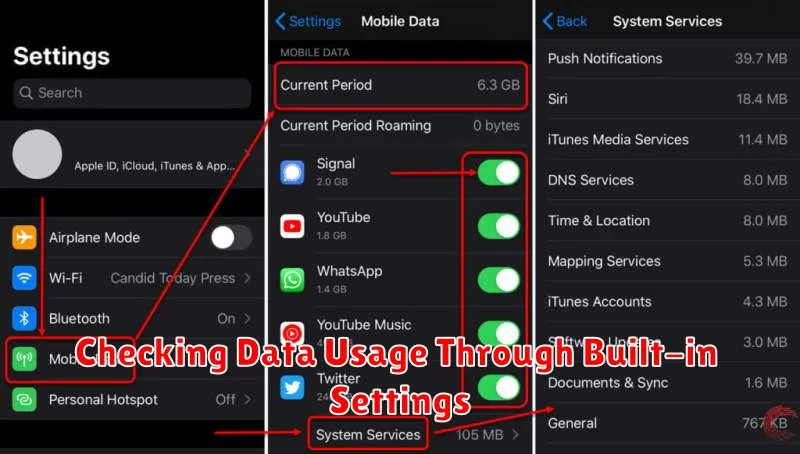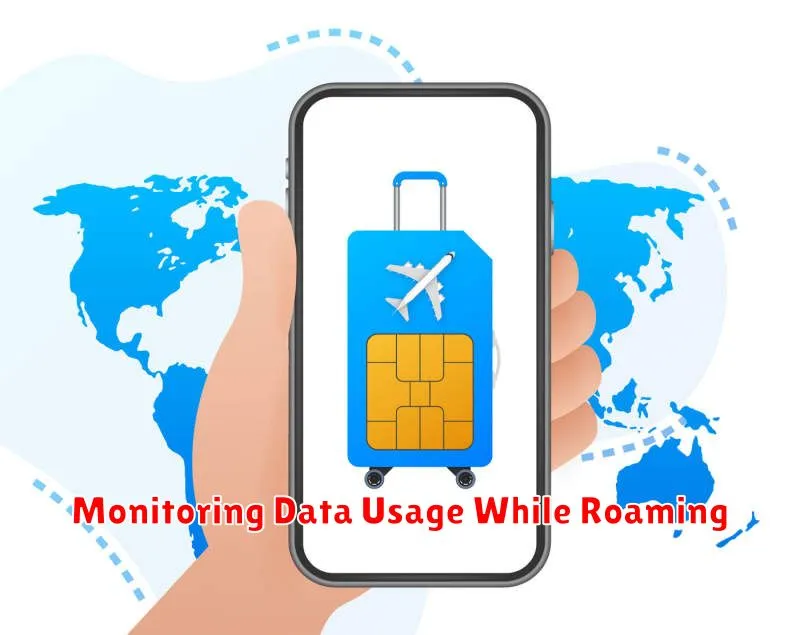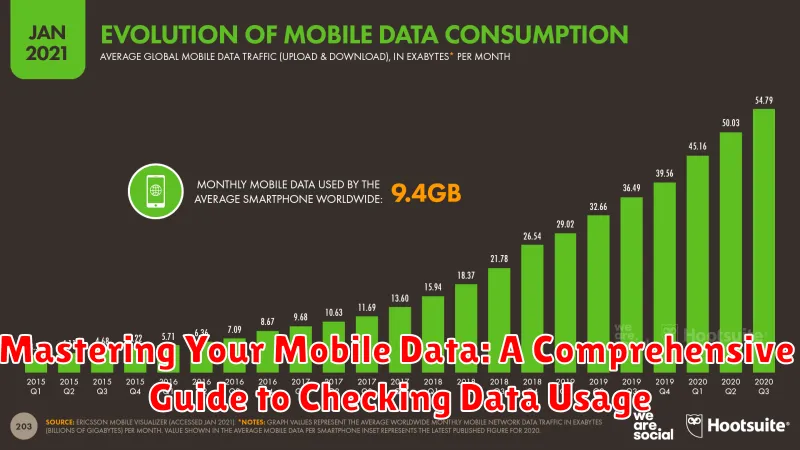In today’s hyper-connected world, mobile data is essential for communication, work, and entertainment. Understanding your data usage is crucial to avoid overcharges, manage your budget, and ensure you have sufficient data for your needs. This comprehensive guide, “Mastering Your Mobile Data,” provides a detailed exploration of how to effectively check data usage on various devices and platforms. We’ll cover everything from built-in device tools to carrier-specific apps, giving you the knowledge to stay informed and in control of your data consumption.
Whether you’re on a limited data plan or simply want to keep track of your data usage trends, this guide is an invaluable resource. Learn how to monitor data usage in real-time, set usage alerts, understand data usage cycles, and identify data-hungry apps. Take control of your mobile data and avoid unexpected bills with the practical tips and techniques presented in “Mastering Your Mobile Data.” Optimize your data plan and enjoy uninterrupted connectivity by mastering the art of data management.
Understanding Your Data Plan
Before diving into the specifics of checking your data usage, it’s crucial to understand the details of your mobile data plan. This understanding forms the foundation for effectively managing your data consumption and avoiding unexpected overage charges.
Key aspects to consider include your data allowance, the billing cycle, and any additional features like rollover data or shared data plans. Your data allowance specifies the amount of data you can use each billing cycle. The billing cycle defines the period over which your data usage is measured and reset. Knowing your billing cycle is essential for predicting and managing your data usage trends.
Familiarize yourself with the specific terms and conditions of your plan. Some plans offer additional features like rollover data, which allows unused data from one billing cycle to carry over to the next. Others may offer shared data plans where multiple devices share a common data pool.
Checking Data Usage Through Built-in Settings

Most modern smartphones offer built-in tools to monitor data consumption. These settings provide a convenient way to track your usage without installing additional applications. Accessing these settings is generally straightforward, although the exact steps may vary slightly depending on your device’s operating system and manufacturer.
Android Devices
On Android devices, you can typically find data usage information within the “Settings” app. Look for sections like “Network & internet,” “Connections,” or “Data usage.” Within these menus, you should find a detailed breakdown of your data usage, often presented in a graphical format. You can usually adjust the billing cycle to align with your data plan’s cycle for accurate tracking.
iOS Devices
For iOS users, data usage details are typically accessible through the “Settings” app. Navigate to “Cellular” or “Mobile Data.” Here, you’ll find an overview of your current period’s cellular data usage. Scrolling down often reveals a breakdown of usage by app, allowing you to pinpoint data-hungry applications.
Using Carrier Apps for Data Monitoring
Most major carriers offer dedicated mobile applications designed to simplify account management, including real-time data monitoring. These apps provide a convenient way to track your data usage, often with more detailed breakdowns than your device’s built-in settings.
Carrier apps typically display your current billing cycle, data allowance, and the amount of data you’ve consumed. Some apps also offer historical data usage charts, allowing you to visualize your data consumption patterns over time. This can be valuable for understanding your typical usage and adjusting your data plan if needed.
Key benefits of using carrier apps for data monitoring often include the ability to manage multiple lines on a family plan, view and pay bills, and access customer support directly through the app. Download your carrier’s official app from your device’s app store to explore its data monitoring features.
Third-Party Apps for Data Tracking
Beyond your device’s built-in tools and carrier-provided apps, a range of third-party applications offer extensive data monitoring and management features. These apps often provide a centralized platform for tracking data usage across multiple devices or even for families. They can offer granular insights into which apps consume the most data, helping you identify potential data hogs.
Many third-party apps offer customizable alerts and notifications. You can set thresholds for data usage warnings and receive notifications when you approach your limits. Some even offer tools to predict your usage based on historical patterns, enabling proactive data management.
Selecting a reputable and secure third-party app is crucial. Look for apps with positive reviews, transparent privacy policies, and a proven track record. Ensure the app aligns with your specific needs, whether it’s detailed usage analytics, data compression features, or shared family plans management.
Setting Data Usage Limits and Alerts
Proactively managing your data consumption involves setting usage limits and alerts. This feature, often available within your device’s settings or through your carrier’s app, allows you to define a threshold for data usage within a given billing cycle.
Once you approach or exceed this predefined limit, you’ll receive an alert. This notification serves as a crucial reminder to adjust your data usage habits, preventing potential overage charges or speed throttling.
Setting data limits typically involves specifying a data amount in gigabytes (GB) or megabytes (MB). You can customize these limits to align with your data plan allowance.
Data alerts can often be customized as well. You might choose to receive alerts at different usage thresholds, such as 80% of your limit and again at 100%.
Some devices and carriers even offer the option to automatically disable mobile data once the set limit is reached. This provides a powerful way to completely avoid exceeding your data allowance.
Tips for Reducing Data Consumption
Managing your mobile data effectively is crucial to avoid unexpected overage charges and maintain a consistent connection. Here are some practical tips to help you minimize your data usage:
Wi-Fi Prioritization
Whenever possible, connect to a trusted Wi-Fi network. This simple step can significantly reduce your reliance on cellular data. Make it a habit to automatically connect to known Wi-Fi networks at home and work.
Data-Saving Apps
Utilize data compression features offered by some browsers and consider using data-saving apps. These apps can compress data before it reaches your device, reducing overall consumption.
Restrict Background Data
Many apps consume data in the background even when you’re not actively using them. Restricting background data usage for non-essential apps can help conserve data. You can manage these settings in your device’s settings menu.
Monitoring Data Usage While Roaming

Roaming charges can quickly escalate, making it crucial to monitor your data usage closely while traveling internationally. Your domestic data plan typically doesn’t apply while roaming, and rates can be significantly higher.
Most mobile providers offer tools to track your roaming usage. Check their app or website for a dedicated roaming data monitor. This feature usually provides real-time updates on your data consumption, allowing you to keep track of your spending and avoid bill shock.
Alternatively, you can manually monitor your usage by regularly checking your phone’s data usage settings. Note the initial reading when you start roaming and track its increase. This method may not be as accurate as a dedicated roaming monitor but still provides a valuable estimate.
Pro Tip: Consider disabling background data for apps while roaming. This prevents apps from using data in the background, which can significantly contribute to increased costs.

